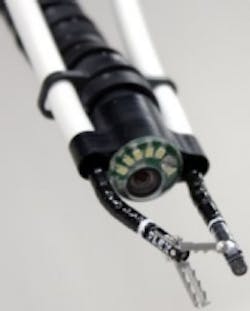Vision-guided snake robots enable minimally invasive surgeries
This past summer we reported on a project out of Carnegie Mellon University’s Robotics Institute which involved vision-enabled snake robots crawling through pipes and valves to inspect a nuclear power plant in Austria. Now, a robot based on the same design will be used by surgeons to access and visualize hard-to-reach anatomical locations for minor surgical procedures.
In the project—which is being led by Howie Choset of Carnegie Mellon and Alon Wolf and Dr. Marco Zenati from Carnegie Mellon spin-off Medrobotics Corp.—a flexible endoscope snake-like robot called the Flex System will be used to extend the benefits of minimally invasive surgery, according to a press release. Much like the robot that was used to inspect difficult-to-reach spaces in a nuclear power plant, this robot will be equipped with LED lighting and an HD video camera on the head of the device, with ports on either side of the camera to accommodate for cutting or grasping tissue.
Flex System robots are controlled by a physician via joystick, which allows maneuverability around organs and other obstructions. Once a robot is able to access a specific anatomical part or location, it deploys specially-designed flexible surgical instruments to perform procedures. Initially developed and tested for heart procedures, the Flex System is now being marketed in Europe on head and neck surgeries accessed through the mouth.
"The Flex System provides a unique platform to access and visualize surgical targets in difficult to reach locations, such as the oropharynx (the area connecting the mouth to the top of the throat) and endolarnyx (within the larynx)," said Dr. Marshall Strome, chairman emeritus of the Cleveland Clinic Head and Neck Institute and a Medrobotics medical adviser.
View the press release.
Also check out:
Robot snakes inspect nuclear power plants
Vision system uses scorpion venom protein and a laser to identify tumors
NASA’s Robonaut 2 humanoid robot learning emergency medical skills
Share your vision-related news by contacting James Carroll, Senior Web Editor, Vision Systems Design
To receive news like this in your inbox, click here.
Join our LinkedIn group | Like us on Facebook | Follow us on Twitter | Check us out on Google +
About the Author

James Carroll
Former VSD Editor James Carroll joined the team 2013. Carroll covered machine vision and imaging from numerous angles, including application stories, industry news, market updates, and new products. In addition to writing and editing articles, Carroll managed the Innovators Awards program and webcasts.
